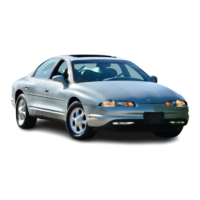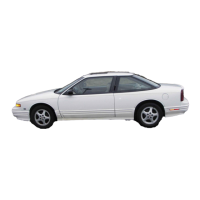
Do you have a question about the Oldsmobile 1999 88 and is the answer not in the manual?
| Brand | Oldsmobile |
|---|---|
| Model | 1999 88 |
| Category | Automobile |
| Language | English |
Explains how to adjust seats, recline seatbacks, and adjust head restraints.
Details proper use of safety belts and what not to do with them, including SRS.
Addresses common questions about safety belts and their interaction with airbags.
Provides instructions for adults on how to wear lap-shoulder belts properly.
Describes the driver's restraint system and how to properly position the seat.
Explains how pregnant women should wear lap-shoulder belts for optimal protection.
Details how to wear the right front passenger's safety belt properly.
Explains the Supplemental Restraint System (SRS) or air bag system, including its function.
Discusses the lap belt used in the center seating position and how to wear it.
Emphasizes the importance of rear seat passengers buckling up for safety.
Describes how to use comfort guides to improve seat belt comfort for children and adults.
Highlights the need for protection for all children and states that laws require restraints.
Lists and describes the different types of add-on child restraints available for vehicles.
Advises children who have outgrown restraints to wear vehicle safety belts.
Explains how to use a safety belt extender if the vehicle's belt is too short.
Advises regular checks of safety belt systems, including belts, buckles, and airbags.
Details when restraint system parts, like belts or airbags, may need replacement after a crash.
Provides a caution about leaving children in vehicles with ignition keys and describes ignition and door keys.
Explains door lock operation, power door locks, and cautions about unlocked doors.
Details how to program automatic door lock features and customize modes.
Explains the feature that delays the actual locking of the vehicle.
Describes rear door security locks that prevent passengers from opening doors from inside.
Explains how to use the remote transmitter to lock/unlock doors and trunk.
Describes how to activate the horn and flashers using the remote lock control.
Lists features that can be programmed for each driver's preference.
Explains how the vehicle provides feedback when a command is received from the remote.
Provides instructions and notices for replacing the battery in the remote lock control transmitter.
Includes a caution about driving with the trunk lid open and guidance on exhaust.
Explains how to release the trunk lid using the steering column button.
Describes how to secure items in the trunk using the glove box switch.
Offers advice on preventing vehicle theft, including key security and parking tips.
Explains the passive theft-deterrent system and its operation.
Provides guidelines for initial vehicle break-in to ensure better long-term performance.
Describes the five ignition switch positions (Accessory, Lock, Off, Run, Start).
Explains the feature that keeps accessories powered after ignition off.
Provides instructions for starting the 3800 Series II V6 engine.
Explains the function and use of the engine coolant heater in cold weather.
Details the operation of the automatic transaxle and shift lever positions.
Offers a caution and steps for safely shifting into PARK (P).
Provides instructions for moving the shift lever into PARK (P).
Explains how to use the console shift lever for PARK (P) and other positions.
Includes a caution about the dangers of leaving the vehicle with the engine running.
Explains torque lock and how to prevent it when parking on a hill.
Provides cautions and steps for shifting out of PARK (P), including troubleshooting.
Includes a caution about parking over flammable materials near hot exhaust parts.
Contains a caution about the dangers of engine exhaust (CO) and what to do if it enters the vehicle.
Offers cautions and tips for running the engine while parked.
Explains power window operation, express-down feature, and window lock.
Details how to operate the express-down feature for automatic window lowering.
Describes how to disable passenger window switches using the window lock.
Explains how to activate the horn using the steering wheel center pad.
Explains how to adjust the steering wheel for driving comfort and entry/exit.
Details turn signals, headlamp changer, wipers, washer, and cruise control.
Describes the two upward/downward positions for signaling turns or lane changes.
Explains how to change headlamps from low to high beam by pulling the lever.
Describes using high-beam headlamps to signal a driver for passing.
Explains the chime that sounds if the turn signal is left on for an extended distance.
Details control of windshield wipers, speed settings, delay, and blade care.
Explains how to spray washer fluid and cautions about freezing weather.
Explains how to maintain speed, its limitations, and how brakes affect it.
Provides cautions and steps for setting cruise control to ON.
Explains how to resume a set speed after applying the brake.
Describes two ways to increase speed while using cruise control.
Details two methods for reducing speed while using cruise control.
Explains how to use the accelerator to increase speed for passing.
Discusses how cruise control performance varies on hills and provides tips.
Outlines two ways to turn off the cruise control.
Explains that set speed memory is erased when the ignition or cruise control is turned off.
Describes how to turn on and off exterior lamps and the lamps on reminder.
Explains how to turn on exterior lamps and the headlamp indicator.
Alerts about a warning tone if lamps are left on when the driver's door is opened.
Explains how DRLs make the vehicle more visible and their operation.
Locates the fog lamp button and specifies conditions for their operation.
Explains how to turn the Twilight Sentinel switch and its function for lighting the way.
Covers instrument panel intensity control, courtesy lamps, illuminated entry, and theater dimming.
Explains how to adjust the brightness of the instrument panel and interior lamps.
Describes how interior lamps turn on when doors are opened.
Explains how interior lamps turn on when a door is opened or UNLOCK is pressed.
Describes how interior lamps stay on after the door is closed.
Explains the fade-out feature for courtesy lamps.
Explains interior lamps coming on for 25 seconds after key removal.
Prohibits dimming of instrument panel displays during daylight.
Explains how to turn front reading lamps on when doors are closed.
Describes how to turn rear reading lamps on and off.
Notes that the trunk lamp comes on when the trunk is opened.
Explains how interior lamps shut off automatically to save battery.
Covers inside day/night manual rearview mirror and electrochromic mirror with compass.
Explains how to adjust the rearview mirror for glare reduction.
Details the automatic dimming mirror with compass and its cleaning.
Explains how to turn the electrochromic mirror on/off and operate the compass.
Describes how to turn the compass on/off and its display.
Provides two methods for calibrating the compass mirror.
Explains how to adjust the compass for variance and find the zone number.
Explains how to adjust the outside rearview mirror with the control lever.
Details how the driver's door lever controls both outside rearview mirrors.
Describes the passenger side mirror as convex and provides a caution about its use.
Covers glove box, map pocket, and front storage armrest.
Explains how to open and lock the glove box.
Notes storage compartments located on each front door.
Explains how to open the front armrest storage area and its features.
Details the front armrest storage area and cupholder operation.
Describes the convenience net inside the trunk for securing small loads.
Explains how to access ashtrays and use the cigarette lighter.
Explains how to use sun visors, extend them, and access the vanity mirror.
Describes how to expose and use the vanity mirror, including lighted options.
Locates the accessory power outlet and notes its load limit.
Notes the folding handles above doors for getting out of the vehicle.
Mentions the availability of rear garment hooks for convenience.
Provides an overview of the instrument panel components with labels.
Explains the purpose of the instrument panel cluster for vehicle status.
Describes how the speedometer and odometer display speed and distance.
Explains how the trip odometer works and how to reset it.
Explains that the tachometer displays engine speed in revolutions per minute (rpm).
Describes warning lights and gages that signal vehicle issues.
Explains the reminder light and chime for seat belt usage.
Describes the AIR BAG light indicating the air bag system's electrical status.
Explains the battery warning light related to the electrical charging system.
Details the brake system warning light, its function, and indicates brake problems.
Explains the ABS warning light and when the system needs service.
Describes the warning light for the traction control system and its possible causes.
Indicates when the traction control system is limiting wheel spin.
Shows the engine coolant temperature gage and actions for overheating.
Explains the check engine light, OBD II system, and notices for driving with it on.
Describes the CHECK OIL light indicating low engine oil level.
Explains the security light that comes on when starting the vehicle.
Discusses owner questions about the fuel gage and normal operation.
Explains how to use the air system for heating, cooling, and ventilation.
Details the mode knob for air delivery direction and fan control.
Explains how to use the A/C system for cooling and dehumidifying the interior.
Provides instructions for using the heating system for warmer air.
Explains how to operate the rear window defogger and cautions against sharp objects.
Describes the flow-through ventilation system and air outlets.
Offers tips for maintaining airflow and preventing window fogging.
Introduces the Delco Electronics audio system and its features.
Provides instructions for setting the time on the vehicle's clock.
Explains how to play the radio, find stations, and use seek/scan functions.
Details how to turn the system on/off and adjust volume.
Explains how to switch between AM/FM bands and tune stations.
Describes how to set and use the five numbered pushbuttons for favorite stations.
Explains the P SCAN mode for scanning preset stations.
Details how to adjust bass, treble, and preset tone settings.
Explains how to adjust speaker balance (BAL) and fade (FADE).
Provides instructions for playing cassette tapes, including error handling.
Explains how to insert and play a compact disc, including error codes.
Explains the THEFTLOCK system that deters radio theft using a secret code.
Provides step-by-step instructions for entering a secret code to activate THEFTLOCK.
Details the procedure to unlock the radio after a power loss using the secret code.
Explains how to disable the THEFTLOCK system by entering the secret code.
Discusses AM and FM stereo reception and factors affecting signal quality.
Offers precautions on adjusting volume to prevent hearing damage.
Provides guidelines for cleaning and maintaining the cassette tape player.
Outlines methods for removing specific stains and odors from fabric.
Explains how to clean vinyl surfaces and cautions about staining agents.
Provides instructions for cleaning leather, including cautions on cleaners.
Recommends mild soap and water for cleaning the instrument panel top surface.
Suggests using mild soap and water for cleaning interior plastic components.
Offers cautions about cleaning safety belts and using mild soap and water.
Explains how to clean glass surfaces and cautions against abrasive cleaners.
Details cleaning the windshield and wiper blades for better visibility.
Explains how silicone grease on weatherstrips improves sealing and longevity.
Discusses maintaining the vehicle's paint finish through washing.
Provides tips for washing the vehicle to preserve its finish.
Suggests using mild water and soap for cleaning exterior lamps and lenses.
Explains the basecoat/clearcoat paint finish and proper waxing/polishing.
Provides instructions for cleaning aluminum wheels and cautions against improper agents.
Suggests using a stiff brush with tire cleaner for cleaning tires.
Emphasizes the need for anti-corrosion material during sheet metal repair.
Advises immediate repair of chips, fractures, or scratches to prevent corrosion.
Recommends flushing the underbody annually to remove corrosive materials.
Explains chemical fallout damage and GM's warranty coverage for new vehicles.
Lists GM-approved cleaning products and their usage.
Explains the legal identifier for the vehicle and its locations.
Explains how the eighth character of the VIN identifies the engine.
Describes the label on the spare tire cover for ordering parts.
Contains notices about adding electrical equipment and the air bag system.
Warns about potential damage from unauthorized electrical additions.
Explains headlamp wiring protection via circuit breaker and overload issues.
Details protection for the wiper motor via circuit breaker and fuse.
Explains how circuit breakers protect power windows and accessories.
Describes how to check fuses in the underhood fuse center.
Explains protection from short circuits via fuses, breakers, and thermal links.
Locates the driver's side fuse block and explains fuse removal.
Locates additional fuses on the passenger's side and recommends dealer service for replacement.
Provides information on halogen bulbs and headlamp replacement.
Includes a caution about pressurized halogen bulbs and their replacement instructions.
Directs users to the index for bulb type and details headlamp assembly removal.
Explains how to remove the bulb housing and replace the bulb.
Advises inspecting wiper blades and replacing worn inserts.
Discusses tire quality, warranty, and safety precautions for tires.
Explains how to check tire pressure and cautions about under/overinflation.
Details tire rotation intervals, inspection, alignment, and balancing.
Describes indicators for needing new tires and buying new tires.
Explains how to find the correct tire size and TPC Spec number.
Relates tire grading system to treadwear, traction, and temperature performance.
Explains factory alignment/balancing and when re-adjustment may be needed.
Provides cautions for replacing wheels, bolts, and nuts with correct parts.
Warns against using used wheels due to potential failure and safety risks.
Provides notices on using tire chains legally and correctly for safety.
Offers the best advice for driving: drive defensively and expect the unexpected.
Highlights drinking and driving as a national tragedy and its effects on driving ability.
Explains the three systems controlling vehicle movement: brakes, steering, and accelerator.
Discusses perception and reaction time in braking, and factors affecting stopping distance.
Explains the ABS system that helps prevent braking skids.
Covers power steering and tips for driving on curves.
Provides advice on driving on curves safely.
Explains the physics of curves and the importance of adjusting speed.
Details how steering can be more effective than braking in emergencies.
Provides instructions on how to recover the vehicle if wheels drop off the road.
Offers tips for safely passing another vehicle on a two-lane highway.
Explains situations leading to loss of control and how to react in emergencies.
Describes three types of skids and how to handle them.
Offers tips for night driving, including defensive driving and night vision.
Discusses factors affecting night vision and how to improve it.
Provides advice for driving safely in rain and on wet surfaces.
Explains the dangers of hydroplaning and how to avoid it.
Warns about water entering the engine through the air intake and how to navigate puddles.
Offers ways to increase safety in city driving, focusing on traffic and signals.
Provides advice on freeway driving, including blending with traffic and lane discipline.
Offers pre-trip checks for vehicle readiness, rest, and weather forecasts.
Discusses highway hypnosis and provides tips to stay alert.
Explains how driving on steep hills and mountains differs from flat terrain.
Offers tips for winter driving and suggests preparing emergency supplies.
Provides advice for driving on slippery surfaces and using traction control.
Gives steps to summon help and stay safe if stopped by heavy snow.
Explains how to tow your vehicle behind another for recreational use.
Shows how to find weight limits and cautions about overloading the vehicle.
Provides essential tips and safety rules for towing a trailer.
Offers advice on trailer handling, braking, passing, and backing up.
Recommends staying at least twice the normal distance behind vehicles.
Advises making wider turns when trailering to avoid contact with the vehicle.
Explains the need for different turn signal flashers and checking trailer bulbs.
Provides advice on driving downhill and uphill, including gear selection.
Includes a caution against parking a vehicle with a trailer attached on a hill.
Explains how to use hazard warning flashers to warn others and signal a problem.
Suggests using reflective triangles to warn oncoming traffic.
Provides cautions and steps for safely jump-starting a vehicle's battery.
Offers cautions for towing and advises using proper equipment to avoid damage.
Includes cautions about steam from overheated engines and stopping the vehicle.
Describes engine cooling system components and cautions about electric fans.
Offers tips on what to expect and do when a tire blows out or leaks air.
Provides cautions about injury during tire changes and steps to prevent vehicle movement.
Explains how to access the spare tire and tools stored in the trunk.
Details how to remove and reinstall wheel covers and nut caps.
Provides steps for loosening wheel nuts, raising the vehicle, and changing a tire.
Explains the temporary use of compact spare tires and cautions against mixing wheels.
Offers cautions about spinning wheels and explains the 'rocking' method to get unstuck.
Provides steps for rocking the vehicle using forward/reverse gears.
Recommends using the dealer for service and highlights genuine GM parts.
Advises using the proper service manual and keeping service records.
Recommends using regular unleaded gasoline with 87 octane or higher.
Warns that external additions can affect airflow, noise, and washer performance.
Advises on checking fuel availability and avoiding unrecommended fuels abroad.
Provides cautions about gasoline vapor and refueling procedures.
Includes cautions about filling portable containers outside the vehicle to prevent static discharge.
Introduces checking fluids, lubricants, and underhood parts.
Explains how to open the hood using the interior release handle.
Identifies key components under the hood.
Explains the CHECK OIL light and the importance of checking engine oil regularly.
Provides steps for checking the engine oil level using the dipstick.
Details when to add oil and cautions against adding too much.
Explains how to identify recommended oils and proper viscosity grades.
Advises against adding anything to the oil and consulting the dealer.
Outlines maintenance schedules for changing oil and filter based on driving conditions.
Explains the location and function of the engine air cleaner and filter.
Provides guidance on the safe use and disposal of used engine oil.
Details when to check and change automatic transaxle fluid and filter.
Provides steps for checking the automatic transaxle fluid level.
Explains how to check the fluid level at normal operating temperature.
Guides on adding transaxle fluid, referencing maintenance schedule and cautions.
Explains the DEX-COOL coolant system, its longevity, and benefits.
Recommends a 50/50 mixture of clean water and DEX-COOL coolant.
Provides guidelines for checking coolant level when the engine is cold or warm.
Explains how to add coolant to the recovery tank and cautions about hot systems.
Details the radiator cap's pressure rating and installation instructions.
Explains the thermostat's role in controlling engine coolant temperature.
Explains when to check power steering fluid and how to check the level.
Provides instructions on what to use and how to add windshield washer fluid.
Covers brake fluid, its level, and cautions about topping off.
Explains the brake fluid reservoir and reasons for fluid level decrease.
Specifies DOT-3 brake fluid and cautions against using the wrong fluid.
Describes brake pad wear indicators, squealing sounds, and rear brake inspection.
Advises seeing a dealer if the brake pedal does not return to normal height.
Emphasizes using approved GM parts for brake system replacement.
Recommends ACDelco Freedom batteries and provides vehicle storage advice.
Explains how to prepare the vehicle for storage by disconnecting the battery.
Provides cautions for halogen bulbs and instructions for headlamp replacement.
Includes a caution about pressurized halogen bulbs and their replacement instructions.
Directs users to the index for bulb type and details headlamp assembly removal.
Explains how to remove the bulb housing and replace the bulb.
Advises inspecting wiper blades and replacing worn inserts.
Discusses tire quality, warranty, and safety precautions for tires.
Explains how to check tire pressure and cautions about under/overinflation.
Details tire rotation intervals, inspection, alignment, and balancing.
Describes indicators for needing new tires and buying new tires.
Explains how to find the correct tire size and TPC Spec number.
Relates tire grading system to treadwear, traction, and temperature performance.
Explains factory alignment/balancing and when re-adjustment may be needed.
Provides cautions for replacing wheels, bolts, and nuts with correct parts.
Warns against using used wheels due to potential failure and safety risks.
Provides notices on using tire chains legally and correctly for safety.
Discusses the importance of vehicle maintenance for safety, environment, and performance.
Highlights how proper maintenance protects the environment and vehicle condition.
Explains the five parts of the maintenance schedule and provides cautions for DIY work.
Details services to be performed and when, emphasizing GM-trained service.
Explains how different driving habits affect maintenance needs.
Guides users on deciding between Short Trip/City and Long Trip/Highway schedules.
Summarizes maintenance services and intervals for Short Trip/City driving.
Defines conditions that necessitate the Short Trip/City maintenance schedule.
Lists specific maintenance intervals for Short Trip/City driving.
Defines conditions that require the Long Trip/Highway maintenance schedule.
Lists specific maintenance intervals for Long Trip/Highway driving.
Provides checkboxes for recording maintenance performed at various mileage intervals.
Provides checkboxes for recording maintenance performed at various mileage intervals.
Lists owner checks and services to ensure safety, dependability, and emission performance.
Recommends underhood checks to be performed at each fuel fill.
Explains how to check engine oil level and add oil if necessary.
Guides on checking engine coolant level and adding DEX-COOL mixture.
Explains how to check windshield washer fluid level and add fluid.
Lists checks to be performed at least once a month.
Emphasizes checking tire inflation pressure regularly.
Recommends cleaning the cassette deck every 50 hours of tape play.
Advises cleaning the power antenna mast for optimal performance.
Lists checks and services to be performed at least twice a year.
Ensures safety belt reminder light and system parts are working properly.
Inspects wiper blades for wear or cracking and recommends replacement.
Explains how silicone grease on weatherstrips improves sealing and longevity.
Checks transaxle fluid level and indicates potential problems from fluid loss.
Lists checks and services to be performed at least once a year.
Recommends lubricating key lock cylinders with specified lubricant.
Details lubricating all body hinges, latches, and hardware.
Provides steps to check the starter switch operation in each gear.
Details how to check the BTSI system for proper park lock function.
Checks if the ignition key turns to LOCK only when the shift lever is in PARK (P).
Checks parking brake and PARK (P) mechanism holding ability on a hill.
Recommends flushing underbody annually to remove corrosive materials.
Explains inspections performed by dealers or qualified service centers.
Inspects suspension, steering, and drive axle components for damage or wear.
Inspects the exhaust system for damage, leaks, or loose connections.
Inspects cooling system hoses, fittings, and radiator for condition.
Inspects the throttle system for interference, binding, or wear.
Inspects brake lines, hoses, pads, rotors, drums, and parking brake.
Suggests additional brake service for corrosive environments.
Lists recommended fluids and lubricants for vehicle maintenance.
Provides space to record maintenance performed and retain receipts.
Lists owner checks and services to ensure safety, dependability, and emission performance.
Explains inspections performed by dealers or qualified service centers.
Lists recommended fluids and lubricants for vehicle maintenance.
Provides space to record maintenance performed and retain receipts.
Discusses the importance of vehicle maintenance for safety, environment, and performance.
Highlights how proper maintenance protects the environment and vehicle condition.
Explains the five parts of the maintenance schedule and provides cautions for DIY work.
Details services to be performed and when, emphasizing GM-trained service.
Explains how different driving habits affect maintenance needs.
Guides users on deciding between Short Trip/City and Long Trip/Highway schedules.
Summarizes maintenance services and intervals for Short Trip/City driving.
Defines conditions that necessitate the Short Trip/City maintenance schedule.
Lists specific maintenance intervals for Short Trip/City driving.
Defines conditions that require the Long Trip/Highway maintenance schedule.
Lists specific maintenance intervals for Long Trip/Highway driving.
Provides checkboxes for recording maintenance performed at various mileage intervals.
Provides checkboxes for recording maintenance performed at various mileage intervals.
Lists owner checks and services to ensure safety, dependability, and emission performance.
Recommends underhood checks to be performed at each fuel fill.
Explains how to check engine oil level and add oil if necessary.
Guides on checking engine coolant level and adding DEX-COOL mixture.
Explains how to check windshield washer fluid level and add fluid.
Lists checks to be performed at least once a month.
Emphasizes checking tire inflation pressure regularly.
Recommends cleaning the cassette deck every 50 hours of tape play.
Advises cleaning the power antenna mast for optimal performance.
Lists checks and services to be performed at least twice a year.
Ensures safety belt reminder light and system parts are working properly.
Inspects wiper blades for wear or cracking and recommends replacement.
Explains how silicone grease on weatherstrips improves sealing and longevity.
Checks transaxle fluid level and indicates potential problems from fluid loss.
Lists checks and services to be performed at least once a year.
Recommends lubricating key lock cylinders with specified lubricant.
Details lubricating all body hinges, latches, and hardware.
Provides steps to check the starter switch operation in each gear.
Details how to check the BTSI system for proper park lock function.
Checks if the ignition key turns to LOCK only when the shift lever is in PARK (P).
Checks parking brake and PARK (P) mechanism holding ability on a hill.
Recommends flushing underbody annually to remove corrosive materials.
Explains inspections performed by dealers or qualified service centers.
Inspects suspension, steering, and drive axle components for damage or wear.
Inspects the exhaust system for damage, leaks, or loose connections.
Inspects cooling system hoses, fittings, and radiator for condition.
Inspects the throttle system for interference, binding, or wear.
Inspects brake lines, hoses, pads, rotors, drums, and parking brake.
Suggests additional brake service for corrosive environments.
Lists recommended fluids and lubricants for vehicle maintenance.
Provides space to record maintenance performed and retain receipts.
Outlines steps to resolve concerns with dealership management and Oldsmobile.
Provides TTY contact numbers for customers with hearing or speech impairments.
Lists contact information for Oldsmobile's Customer Assistance Network.
Details a program reimbursing up to $1,000 for adaptive equipment.
Lists services provided by Oldsmobile's Roadside Assistance program.
Provides the Oldsmobile Roadside Assistance number and its benefits.
Offers roadside assistance information for vehicles purchased in Canada.
Explains the program offering transportation options during warranty repairs.
Advises contacting the dealer to schedule warranty service and minimize inconvenience.
Lists transportation options like shuttle service and courtesy rental vehicles.
Directs users to the warranty booklet for detailed warranty information.
Instructs on reporting vehicle defects to NHTSA and General Motors.
Instructs on reporting vehicle safety defects to Transport Canada and General Motors.
Encourages owners to notify General Motors about safety defects.
Provides information on ordering service and owner manuals in Canada.












